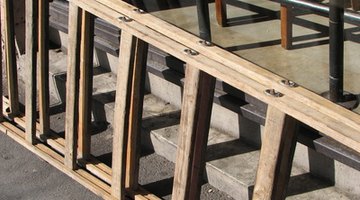How to Tie a Ladder Halyard
Extension ladders utilize a halyard rope for easing the process of extending and lowering the ladder. The halyard runs through a pulley attached to the top section of the ladder. When extended, the halyard sits on the ground, causing a tripping hazard.

Tying the halyard to the ladder keeps it from lying on the ground, eliminating the tripping hazard and protecting the rope from abrasion damage. A clove hitch knot ties and unties quickly, and it's the knot of choice for firefighters and other professionals who frequently use ladders.
-
Extend the extension ladder. Place the ladder against the side of a building. Make sure the ladder extends at least three feet beyond the edge of the roof and rests at the proper angle to the building by placing the tips of your feet at the base of the ladder and extending your arms toward the rung sitting at eye level. If your fingertips touch the rung, the ladder is at the proper angle.
-
Start the clove hitch knot by grabbing the end of the halyard rope with one hand. Feed the end of the rope toward the front of the extension ladder through one rung of the lower section of the extension ladder. Standing between the ladder and the building, pull the rope toward you, two rungs up from the area you fed the rope through the ladder.
-
Wrap the halyard rope counterclockwise around the rung of the ladder. Double up the remaining length of rope. Feed the end of the loop between the line wrap and the ladder rung. Pull the loop 12 inches beyond the rung of the ladder.
-
Pull the end of the rope and the rope hanging down from the ladder rung away from each other to lock the clove hitch knot in position.
-
Pull the loose end of the loop to untie the clove hitch knot and release the halyard line from the lower section of the extension ladder.
References
Photo Credits
- Wooden ladder image by Tasha from Fotolia.com
- Wooden ladder image by Tasha from Fotolia.com
More Articles



